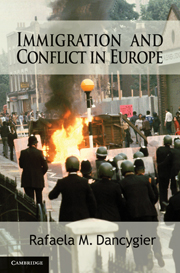Book contents
- Frontmatter
- Contents
- List of Figures and Tables
- Acknowledgments
- PART I GENERAL INTRODUCTION AND THEORETICAL FRAMEWORK
- PART II INTRODUCTION TO PART II
- PART III INTRODUCTION TO PART III
- PART IV INTRODUCTION TO PART IV
- 9 Conclusion
- Appendix A Coding Large-Scale Instances of Immigrant–Native and Immigrant–State Violence
- Appendix B Data and Variables: Immigrant Turnout
- References
- Index
- Titles in the series
Appendix A - Coding Large-Scale Instances of Immigrant–Native and Immigrant–State Violence
Published online by Cambridge University Press: 17 November 2010
- Frontmatter
- Contents
- List of Figures and Tables
- Acknowledgments
- PART I GENERAL INTRODUCTION AND THEORETICAL FRAMEWORK
- PART II INTRODUCTION TO PART II
- PART III INTRODUCTION TO PART III
- PART IV INTRODUCTION TO PART IV
- 9 Conclusion
- Appendix A Coding Large-Scale Instances of Immigrant–Native and Immigrant–State Violence
- Appendix B Data and Variables: Immigrant Turnout
- References
- Index
- Titles in the series
Summary
I adopted the following rules for deciding which events should count as instances of large-scale immigrant–native and immigrant–state violence:
The event has to be mentioned in at least one of Britain's two major national newspapers, The Times or The Guardian.
The event has to be discussed in the quite extensive social science secondary literature.
London witnessed more violent events in July 1981 than Table 3.1 indicates, but not all of these events should be characterized as large-scale violence. Keith (1993) has devised an intensity ranking of “all serious incidents of public disorder” occurring in London in July 1981, drawing on a list compiled by the Home Office. These rankings are based on a “quantitative measure of the type and extent of damage suffered by property at the scene of disorder…a quantitative measure of the type and extent of violent conflict at the scene of disorder,” and the existence and use of petrol bombs as “one particular element of the ‘rioting armoury’ as symptomatic of the escalation of violence” (Keith 1993, 111). I am including those events that ranked in the top ten (out of twenty-seven), according to Keith's index (only nine appear in the table since Keith counts events in Southall as two consecutive incidents).
[…]
- Type
- Chapter
- Information
- Immigration and Conflict in Europe , pp. 299 - 300Publisher: Cambridge University PressPrint publication year: 2010



